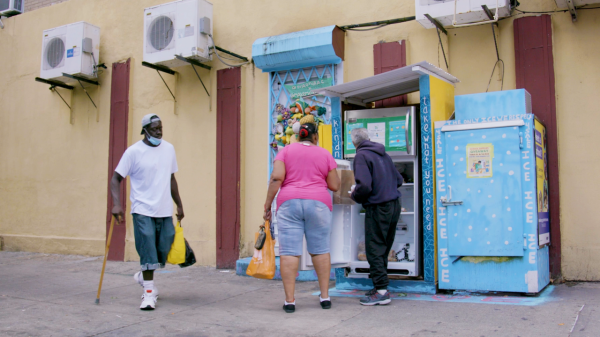
Dodd likened New York’s community fridges, which are often decorated with murals, to “public-art installations” that could alter people’s relationships with “public space, shared resources, and one another.”
One afternoon in May of 2020, Seantell Campbell dropped off a few loaves of bread at a fridge plugged in on the sidewalk, at a street corner near Morningside Park. Anyone could leave food in the fridge, and anyone could stop by to take something they needed. It had been placed there a few weeks earlier—one of many community fridges that mutual-aid organizers and other volunteers were installing around the city in an effort to address the spike in food insecurity caused by the pandemic. Food banks and soup kitchens were so strained that many had run out of supplies and were forced to turn people away; this model offered a different, simpler way to get food into people’s hands. Campbell, who is a veteran and a full-time student, had heard of the concept of community fridges years earlier, but seeing one operating successfully so close to home made her think that she might be able to run one herself. A month later, with help from Darrielle Carter, a longtime friend who had just been furloughed from her job in event planning, she opened the Barrio Fridge on a street in East Harlem near her apartment. Eight months later, Campbell and Carter started a second fridge a couple of blocks away.
Nikki Dodd, a filmmaker based in Brooklyn, met Campbell and Carter through a mutual friend in the summer of 2021. Dodd had watched the community-fridge movement gain momentum in New York, and was intrigued by how something as simple as plugging a fridge in on the street could, on a small scale, address hunger and reduce food waste at the same time. Dodd was also struck by the visual effect of the fridges themselves, which are often decorated with murals. “They seem to me like public-art installations,” Dodd told me, with the potential to alter people’s relationships with “public space, shared resources, and one another.” A wooden shelter over Campbell and Carter’s first fridge was painted yellow and blue by a local artist, working with her students; they added snippets of text and, on one side, a woman’s face surrounded by dollops of color.
The New Yorker Documentary
View the latest or submit your own film.

Dodd’s film follows Campbell as she goes about the daily business of keeping the fridges functioning: picking up donations, wrangling volunteers, organizing and cleaning, encouraging neighbors passing by to take food if they need it. In one interview with Dodd, Campbell reflects on the challenge of doing all of this with very limited resources. “If I had more money, I’d be addressing housing. But all I had was a little piece of a corner and an electrical unit, and a fridge was born,” she says, and gives a shrug.
Community fridges have a tendency to disappear as quickly as they appear. They can be destroyed by bad weather or technical problems, or simply by the evaporating patience of the business owners who agree to let them be plugged in outside of their buildings. This summer, Campbell and Carter had to shut down their first fridge. The loss hasn’t slowed them down much. The second fridge is still operating, and Campbell estimates that up to a hundred people a day stop by. She has started organizing events to distribute school supplies, toys, and, at Thanksgiving, free turkeys. In Dodd’s view, the community network that Campbell and Carter have built in the past two years has the potential to go even further: “the sky’s the limit in terms of what Seantell can think of for her neighborhood, ” she told me. When the pair removed their first fridge, its painted wooden frame was left standing alone, labelled “take what you need.” ♦
Sourse: newyorker.com






